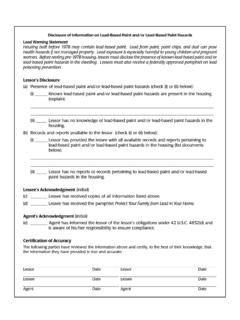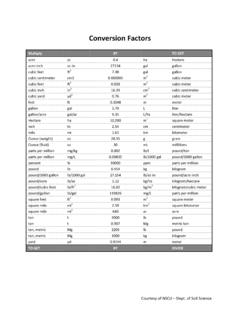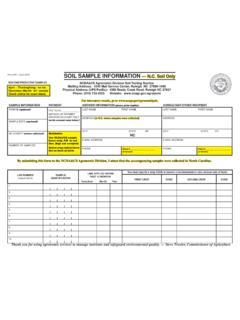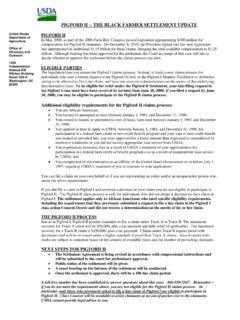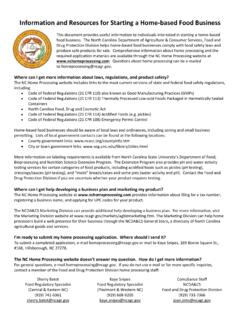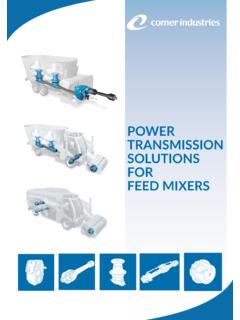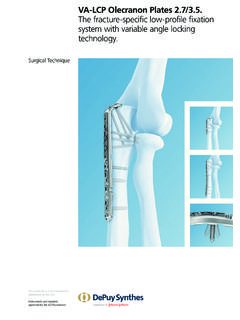Transcription of Thermometer Calibration Guide
1 1 ThermometerCalibration GuideNancy C. Flores, Boyle, ,Associate ProfessorKansas State UniversityAgricultural Experiment Station andCooperative Extension ServiceTemperature is a critical measurement for ensuring the safetyand quality of many food products. There are a variety of commer-cial temperature monitoring devices available. Whether monitor-ing temperatures at receiving, throughout production or finalproduct storage and distribution, Thermometer Calibration isessential. The validation, verification reassessment section of theHazard Analysis and Critical Control Point (HACCP) system statedin the Code of Federal Regulations (9 CFR 3 ) specifies thatinstruments used for monitoring critical control points must becalibrated.
2 The food industry is keenly aware of the critical natureof processing temperature requirements. Instrument Calibration isnot only a food safety issue, but also an economic considerationsince accuracy of temperature monitoring devices also affectsproduct National Institute ofStandards and Technology(NIST) is an agency withinthe U. S. Department ofCommerce which providescertification and calibrationfor thermometers and otherprecision instruments . Whenpurchasing a thermometercheck for the NIST NIST label indicates acertified instrument that willmaintain accuracy withinspecified limits, for at leastone year. Each year, an NIST Thermometer must be recerti-fied to assure accuracy. This isa service usually provided bythe manufacturer of the ther-mometer or an NIST calibra-tion is the processof standardizing a tempera-ture monitoring instrument toensure that it will measurewithin a specific temperaturerange in which the instrumentis designed to operate.
3 Accu-racy of a Thermometer is itsability to measure tempera-ture correctly without Thermometer must be with-in 2 F ( C) of the actualtemperature to be consideredan accurate device. A ther-mometer s ability to detectsubtle changes in temperatureis its sensitivity. For example,a bi-metal coil thermometercan detect a degreetemperature change, while athermistor may detect a temperature change. It is recommended thatprocess or product tempera-ture monitoring equipmentbe calibrated daily, before equipment must becalibrated upon receipt andbefore putting into , thermometers that havebeen dropped on the floor orused frequently must becalibrated more often. De-pending on the instrumentand intended temperature userange, an ice water methodand boiling water method,when used properly, areeffective Calibration technique is to usesophisticated calibrationequipment available frommanufacturers.
4 These unitsare designed to calibrateseveral thermometers at onetime within a specific tem-perature range. Many of theseunits are able to interface witha computer to assist with re-cord keeping. The calibrationmethod used at your facilitydepends on the temperaturemonitoring instrument,monitoring frequency andintended use, and whether for2product or environmental monitoring. Other accept-able methods may also be used to calibrate tempera-ture monitoring methods are presented for the followingtemperature monitoring instruments : bi-metal coilthermometer, thermocouple Thermometer , and ther-mistor Thermometer . Calibration of non-productcontact thermometers such as Resistance TemperatureDetector (RTD), oven temperature recording devicesand infrared thermometers are also described.
5 A majorconsideration when using any Thermometer is theconsistency of the product and temperature distribu-tion throughout the product. For instance, to measurethe internal temperature of a hamburger patty1 8 inch (3 mm) thick would require using an instru-ment having a thin probe that can detect temperaturequickly and accurately. measuring the internal tem-perature of a bone-in ham could be done adequatelyusing a thick probe having a 2- to 3-inch ( to cm)temperature sensing region. The product type or theenvironment to be monitored will influence theselection of the most effective temperature monitoringinstrument to ThermometersLaboratory and industry supply catalogs marketNIST reference thermometers. Local county extensionagents or high school science teachers may have thesecatalogs.
6 A temperature monitoring device such as amercury-in-glass Thermometer or a thermistor can beused as a reference Thermometer as long as the deviceis NIST certified and the annual Calibration andcertification is maintained through an NIST Coil ThermometerCommon types of bi-metal coil thermometers aredial and instant read digital thermometers. Containedwithin the stem of the Thermometer is a coil made oftwo different metals bonded together to a temperatureindicator. This type of Thermometer detects tempera-tures from the tip of the stem to a point 2 to 21 2 inches( to cm) above the tip. An indentation in thestem indicates the area of the stem that is the tempera-ture sensing region. The temperature indicated on thedial is an average of temperatures along this thermometers must be inserted 2 to 3 inches( to cm) into the geometric center of a fluctuation in temperature along the sensingregion can affect the extension of the bi-metal coil,which affects Thermometer accuracy.
7 Bi-metal ther-mometers are sensitive to physical stress such astorque on the stem, or shock from dropping on thefloor. These stresses can affect the tension of the bi-metal coil, which necessitate Calibration of the ther-mometer before coil Thermometer Calibration methodCalibration for use in hot processes and products(boiling water method):Once these supplies are assembled, the followingsteps are used to calibrate bi-metal coil thermometersfor use in hot Heat distilled water to a specific reference tempera-ture. This reference temperature can be 212 F(100 C) described as a rolling boil at sea levelaltitude. The boiling point of water changes withaltitude. To find the correct boiling point for yourarea, refer to Figure 1, Boiling point of water withrelationship to altitude.
8 An alternative referencetemperature for example is the target end tempera-ture of a product. Specifically, if the intended use ofthe Thermometer is to measure the final internaltemperature of a cooked uncured turkey roll at theend of thermal processing, then a target tempera-ture of 160 F (71 C) should be used forthe reference Once the distilled water has reachedthe reference temperature, place thethermometer to be calibrated in thehot water bath. Immerse the stem to aminimum depth of 21 2 inches ( cm).Place the NIST reference thermometerin the water bath at the same time, tothe same depth, as the bimetal coilthermometer. Make sure that neitherthermometer comes in direct contactwith the bottom of the heated con-tainer or each items needed for calibrating thermometers used inhot processes are.
9 One pint (500 ml) PyrexTM or heat tolerant con-tainer Distilled water Heat source such as a hot plate NIST reference thermometerAdvantages of bi-metal coilthermometers Inexpensive, readily available Easy to calibrate Used for final end pointtemperature checkDisadvantages of bi-metalthermometers Temperature averaged over 2-inch ( cm) area of probe(sensing region) Lose Calibration with physicalshock Cannot be used over a widerange of temperaturemeasurement Variable product temperaturein sensing region After one minute, compare the bi-metal coil ther-mometer reading to the NIST reference thermom-eter. Record the readings of the two instruments ona record-keeping form such as a thermometercalibration Correct the indicator needle of the bi-metal coilthermometer.
10 Adjust the spring on the coil byturning the hex nut directly behind the faceplate ofthe Thermometer . Digital instant read thermometersmay have a Calibration button to adjust the tem-perature reading. If the Thermometer cannot bephysically calibrated and the accuracy of the unit ismore than 2 F ( C) then the unit should not beused. Contact the Thermometer manufacturer forfurther Recheck the temperature reading on the bimetal coilthermometer after making any adjustments. This isaccomplished by repeating steps 1 through 3. Thecalibration adjustment should be noted in thethermometer Calibration Once a bi-metal coil Thermometer has been cali-brated for high temperature use, label the thermom-eter for use in this temperature range.


